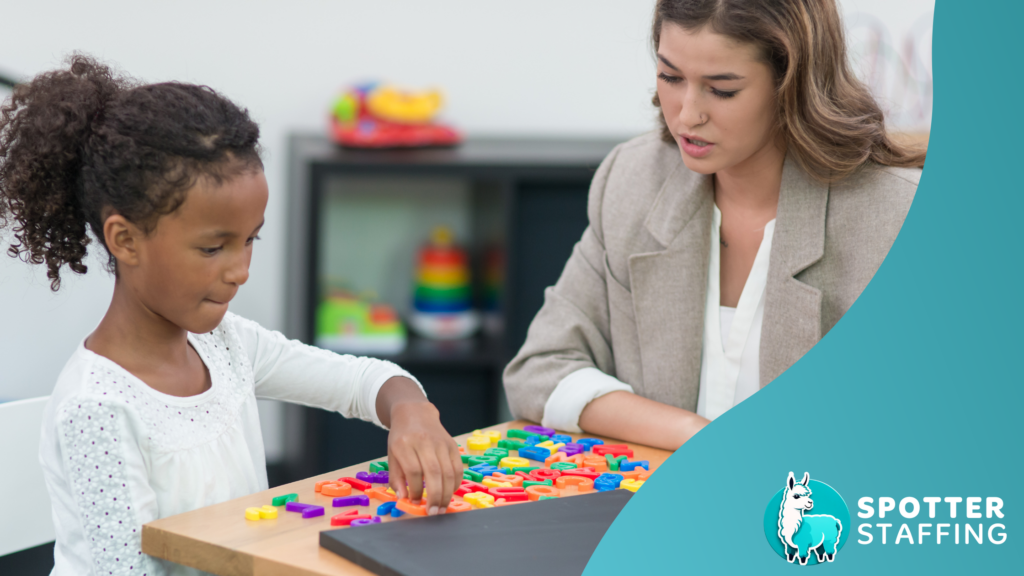Every student with Autism Spectrum Disorder (ASD) is unique, with different strengths and challenges. As an occupational therapist (OT) in a school setting, you play a critical role in helping students with ASD succeed academically, socially and emotionally. But what strategies make the biggest impact in the classroom?
By integrating occupational therapy strategies into daily routines, you can support sensory regulation, motor skills, social interactions, and executive functioning—creating an environment where students with ASD feel safe and empowered to learn.
Understanding the Needs of Students with ASD
Before diving into specific strategies, it’s important to first understand the challenges that students with autism may face in the classroom. Every child is unique, but there are some common difficulties that can make school life more overwhelming for them. By recognizing these challenges, educators and support staff can better anticipate students’ needs and create a learning environment where they feel comfortable and supported.
One of the biggest hurdles for many students with autism is sensory sensitivity. A bright, noisy classroom that seems normal to most students might feel completely overwhelming to a child with autism. Harsh fluorescent lights, the hum of a projector, or even the texture of their desk chair can cause discomfort and distraction. Some students may be hypersensitive to certain sounds, while others might seek out sensory input, like deep pressure or movement, to help them feel grounded.
Fine and gross motor challenges can also impact daily classroom activities. Tasks that require coordination, like handwriting, using scissors, or even maintaining balance while navigating a busy hallway, may require extra effort for some students. These difficulties aren’t necessarily due to a lack of ability but rather differences in motor planning and coordination that can make certain movements more difficult.
Social and communication difficulties are another common challenge. Engaging with peers, interpreting facial expressions, and understanding the unspoken rules of conversation can be tough. Group activities that require quick back-and-forth interaction or subtle social cues may feel confusing or exhausting. Some students may struggle with initiating interactions, while others may have difficulty maintaining conversations or understanding sarcasm and figurative language.
Executive functioning deficits can make classroom routines and organization particularly tricky. Managing time, keeping track of assignments, transitioning between activities, and staying on task without getting overwhelmed may require additional support. Without clear structure and guidance, these students might feel lost in the fast-paced nature of a school day.
Finally, self-regulation struggles can affect how students manage emotions and reactions in the classroom. Frustration, anxiety, or sensory overload can sometimes lead to outbursts, withdrawal, or difficulty staying engaged. Transitions, unexpected changes, or challenging assignments may feel overwhelming, making it harder for students to stay focused and participate fully.
By understanding these challenges, educators can take proactive steps to create a more inclusive and supportive learning environment—one that helps students with autism navigate the classroom with confidence and success.
Sensory Strategies for Regulation and Focus
Sensory processing challenges can significantly affect a student’s ability to learn and engage in class. Occupational therapists can help by incorporating sensory-friendly strategies into the classroom:
- Create a Sensory-Friendly Space
- Designate a quiet area in the classroom with calming tools like noise-canceling headphones, weighted lap pads, or fidget tools. This gives students a place to self-regulate when feeling overwhelmed.
- Allow students access to flexible seating options, such as wiggle cushions, therapy balls, or standing desks, to help with sensory needs and improve focus.
- Use Movement Breaks
- Incorporate short movement activities throughout the day, such as stretching, jumping jacks, or yoga poses, to help students regulate their energy levels.
- Consider implementing classroom-based sensory breaks, like “brain breaks” or a quick walk in the hallway, to reset focus and attention.
- Modify Sensory Inputs
- Reduce unnecessary noise in the classroom by using soft lighting, curtains, or sound-dampening materials to minimize auditory distractions.
- Offer sensory tools like stress balls, chewable jewelry, or textured objects to help students self-regulate without disrupting learning.
Supporting Fine and Gross Motor Development
Motor coordination difficulties can impact a student’s ability to participate in classroom activities. OTs can implement strategies to improve fine and gross motor skills:
- Enhance Handwriting and Fine Motor Skills
- Use adaptive tools such as pencil grips, slant boards, or wide-ruled paper to improve handwriting comfort and legibility.
- Encourage activities like using tweezers, threading beads, or playing with putty to strengthen hand muscles needed for writing and other tasks.
- Promote Gross Motor Coordination
- Incorporate movement-based learning activities, such as writing letters in the air or acting out stories, to engage the whole body in learning.
- Support students in structured physical activities, like obstacle courses or guided movement games, to build coordination and motor planning skills.
- Provide Alternative Writing Methods
- Allow students to use voice-to-text technology, typing, or visual storytelling methods if handwriting is a significant challenge.
- Offer interactive whiteboards or tablets as an alternative to paper-and-pencil tasks to support engagement and reduce frustration.
Encouraging Social Skills and Communication
Many students with ASD struggle with social interactions, making it essential to integrate OT strategies that promote communication and peer engagement:
- Teach Social Scripts and Role-Playing
- Use structured scripts to help students navigate common social interactions, such as greeting a peer, asking for help, or joining a conversation.
- Role-playing activities allow students to practice social skills in a safe, supportive setting with guided feedback.
- Use Visual Supports
- Implement visual schedules, social stories, and emotion charts to help students understand expectations and interpret social cues more easily.
- Label classroom areas with visual cues and use picture-based communication boards for students who benefit from non-verbal supports.
- Encourage Peer Interactions in Structured Settings
- Facilitate small-group activities that promote cooperative play and teamwork, such as turn-taking games or collaborative art projects.
- Pair students with ASD with peer buddies who model positive social interactions and provide friendly support during activities.
Building Executive Functioning Skills
Executive functioning challenges can make it difficult for students with ASD to manage time, follow multi-step directions, and stay organized. OTs can help by introducing strategies that enhance executive functioning:
- Break Tasks into Manageable Steps
- Use checklists, timers, and step-by-step visual instructions to help students understand and complete assignments.
- Highlight key information on worksheets with color coding to draw attention to important details and improve comprehension.
- Establish Consistent Routines
- Keep classroom routines predictable and use clear visual schedules to provide structure and reduce anxiety about transitions.
- Provide advance warnings before changes in routine, using countdown timers or verbal cues to help students prepare.
- Support Organizational Skills
- Teach students how to use folders, binders, and labeled containers to keep materials organized.
- Implement digital tools, like task-management apps or calendar reminders, for students who struggle with planning and remembering assignments.
Creating an Inclusive Classroom Environment
Creating an inclusive classroom isn’t just about supporting students with autism—it’s about building an environment where all students feel valued and understood. Small adjustments in teaching approaches and classroom culture can make a significant impact, helping every student thrive. Here are a few simple yet powerful ways educators can foster inclusivity.
Many students may not fully understand autism or neurodiversity, which can sometimes lead to misunderstandings or unintentional exclusion. By teaching students about different ways people communicate, learn, and experience the world, educators can encourage empathy and acceptance. Simple class discussions, books about neurodiverse characters, or activities that highlight different learning styles can help classmates appreciate and celebrate their peers’ unique strengths.
Not all students express their knowledge in the same way, and a one-size-fits-all approach to assignments can be limiting. Offering multiple ways to complete tasks—such as allowing students to draw, type, verbally explain, or use assistive technology—gives every student a chance to succeed in a way that plays to their strengths. This flexibility can reduce frustration, boost confidence, and make learning more accessible for students with autism.
Every student has something they’re passionate about, and tapping into those strengths can make a huge difference in engagement and motivation. Whether it’s incorporating a student’s favorite topic into a lesson, giving them a leadership role in an area they excel in, or using their interests to help them connect with classmates, strengths-based learning fosters confidence and a sense of belonging.
When educators, OTs, and school staff collaborate to implement these inclusive practices, students with autism feel supported—not just academically, but socially and emotionally as well. With the right strategies in place, classrooms can become places where every student feels empowered to reach their full potential.
Take the Next Step in Your OT Career
As a school-based occupational therapist, you have the power to create meaningful change in the lives of students with ASD. Whether you’re looking for new job opportunities or want to grow your impact in the field, Spotter Staffing is here to help.
Contact us today to explore amazing in-school occupational therapy job openings. Plus, discover how you can advance your career while making a lasting difference in students’ lives!


